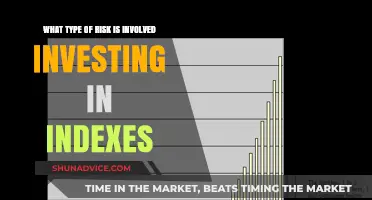
Saving and investing are both important for building wealth, but they are not the same thing. Saving is generally considered safer, but it may not result in the most wealth accumulated over time. Investing, on the other hand, can be riskier but offers the potential for higher returns. So, how do you know which one is right for you?
| Characteristics | Values |
|---|---|
| Risk | Saving is safer as the amount in your bank account won't decrease unless you withdraw funds. Investing is riskier as there is a chance of losing money. |
| Returns | Saving has lower returns than investing. |
| Time horizon | Saving is for the short term, investing is for the long term. |
| Liquidity | Saving provides more liquidity than investing. |
| Purpose | Saving is for emergency funds, unexpected costs, and short-term goals. Investing is for growing your money and achieving long-term financial goals. |
| Types of accounts/instruments | Saving involves bank accounts such as savings accounts, money market accounts, and CDs. Investing involves stocks, bonds, mutual funds, ETFs, property, etc. |
What You'll Learn

Saving for short-term goals
Determine Your Goals
Short-term financial goals typically refer to objectives that you want to achieve within the next five years. These goals can include anything from building an emergency fund, saving for a dream vacation, planning for a wedding, or even saving for a down payment on a house. Clearly defining your short-term goals is essential to help you stay focused and motivated during your financial journey.
Build an Emergency Fund
Life is unpredictable, and unexpected expenses can arise at any time. It is generally recommended to have an emergency fund that can cover your essential expenses for at least three to six months. This fund will act as a safety net, ensuring that you have financial support in case of sudden unemployment, medical emergencies, or other unforeseen situations.
Choose the Right Savings Accounts
When saving for short-term goals, it is crucial to select accounts that offer easy access to your funds without incurring penalties. Traditional savings accounts, money market accounts, and certificates of deposit (CDs) are suitable options. Compare the interest rates, fees, and withdrawal restrictions of different accounts to find the best fit for your short-term savings.
Maximize Your Savings
To accelerate your progress towards short-term goals, consider maximizing your savings by taking advantage of high-yield savings accounts or money market accounts. These accounts often provide higher interest rates than standard savings accounts, helping your money grow faster. Additionally, look for accounts with minimal or no monthly fees to retain more of your earnings.
Automate Your Savings
Automating your savings is a powerful tool to help you save consistently. Set up regular, automated deposits from your paycheck or other income sources directly into your savings account. Many banks and financial apps offer features like rounding up purchases to the nearest dollar and depositing the difference into your savings, making it effortless to save.
Create a Budget and Cut Expenses
Creating a budget and sticking to it is crucial for maximizing your short-term savings. Identify areas where you can cut back on discretionary spending, such as eating out, entertainment, or non-essential subscriptions. Redirect the money you would have spent in these areas into your savings to boost your progress.
Save First, Then Invest
While investing is important for long-term wealth accumulation, it is generally recommended to prioritize saving over investing for short-term goals. The stock market can be volatile in the short run, and you don't want to be forced to sell investments at a loss if you need the money quickly. Focus on building a solid savings foundation first, and then consider investing for the long term once your short-term goals are secured.
In summary, achieving your short-term financial goals requires a disciplined approach to saving. By defining your goals, selecting the right accounts, maximizing your savings, and creating a budget, you can effectively work towards financial milestones and have greater financial security.
Transferring Funds: Ally Invest to Ally Savings
You may want to see also

Investing for long-term goals
When investing for the long term, it's crucial to have a well-defined goal and a clear understanding of your risk tolerance. Here are some steps to consider when investing for long-term goals:
- Define your goal: Are you investing for retirement, your child's education, or another long-term goal? Clearly defining your goal will help you create a plan and stay motivated.
- Assess your risk tolerance: Long-term investing usually involves taking on some level of risk. Determine how much risk you are comfortable with and choose investments accordingly. Diversification can help mitigate risk.
- Choose your investments: Research different investment options such as stocks, bonds, mutual funds, ETFs, or property. Consider working with a financial advisor or using a robo-advisor to build a portfolio that aligns with your goals and risk tolerance.
- Start early: Compound interest works in your favour when investing for the long term. The earlier you start, the more time your investments have to grow.
- Stay disciplined: Long-term investing requires patience and discipline. Stick to your investment plan and avoid making impulsive decisions based on short-term market fluctuations.
- Regularly review and rebalance: Periodically review your investment portfolio to ensure it remains aligned with your goals and risk tolerance. Rebalance your portfolio as needed to maintain your desired asset allocation.
By following these steps and staying committed to your long-term investment strategy, you can increase your chances of achieving your financial goals. Remember that investing involves risk, so it's important to do your own research and consult with professionals before making any decisions.
Invest Wisely: A Guide to Savings in Australia
You may want to see also

Savings accounts vs. investment accounts
Savings accounts and investment accounts are both important for building a sound financial foundation, but they serve different purposes and come with different levels of risk. Here are the key differences between the two:
Savings Accounts
Savings accounts are ideal for short-term financial goals and offer a safe place to park your money. The money in these accounts is easily accessible and typically comes with minimal fees. While the interest rates on savings accounts are usually low, your funds are protected, and you don't have to worry about losing money. Savings accounts are suitable if you need access to your money within the next few years or if you're building an emergency fund. It's recommended to have three to six months' worth of expenses set aside in a savings account.
Investment Accounts
Investment accounts, on the other hand, are meant for longer-term goals. Investing involves buying assets like stocks, bonds, or real estate, with the hope of earning a higher return. Investments have the potential to grow your money more aggressively than savings accounts. However, there is a level of risk involved, and you may lose some or all of your investment. When investing, it's generally recommended to have a time horizon of at least five years, preferably longer, to ride out any short-term downturns.
Key Differences
The biggest difference between saving and investing is the level of risk. Savings accounts are very low-risk, while investments come with the possibility of losing some or all of your money. Savings accounts are ideal for short-term goals and emergencies, while investment accounts are better suited for long-term goals like retirement. Savings accounts offer lower returns but provide easy access to your funds. Investment accounts offer the potential for higher returns but usually require you to keep your money invested for longer periods.
Neither saving nor investing is inherently better, and the right choice depends on your financial goals and circumstances. If you need money in the short term or want to build an emergency fund, savings accounts are the better option. If you're saving for retirement or other long-term goals and can tolerate some risk, investing may be more suitable. Ultimately, it's important to have both savings and investments as part of a well-rounded financial strategy.
From Saving to Investing: Strategies for Your Financial Journey
You may want to see also

Emergency funds
An emergency fund is a safety net for life's unexpected costs, such as medical bills, home or car repairs, or a loss of income. It is recommended to have three to six months' worth of essential expenses in an emergency fund, and this should be easily accessible and separate from your day-to-day spending money.
Create a Savings Habit
Having a specific goal for your savings can help you stay motivated. A good initial goal is to save \$1,000, and then aim for three to six months' worth of living expenses. Set up automatic recurring transfers from your checking account to your savings account. You can also put aside a specific amount of cash on a regular basis, perhaps on payday. Regularly monitor your progress and celebrate your successes.
Manage Your Cash Flow
Keep track of when your money is coming in and going out. You may be able to adjust the due dates for bills and use weeks when you have more money available to boost your savings.
Take Advantage of One-Time Opportunities to Save
If you receive a large cheque, such as a tax refund, save all or part of it to quickly build your emergency fund.
Save Through Work
If you receive your paycheck through direct deposit, ask your employer to divide it between your checking and savings accounts.
Where to Keep Your Emergency Fund
You want your emergency fund to be safe, accessible, and separate from your day-to-day spending money. A dedicated account with a bank or credit union is generally considered one of the safest options. A prepaid card can also be used, or you can keep cash on hand at home or with a trusted family member or friend (although this is less secure).
When to Use Your Emergency Fund
Set guidelines for what constitutes an emergency. This fund is for unplanned expenses or financial emergencies, such as car repairs, home repairs, medical bills, or a loss of income. Using a credit card or taking out a loan to cover these expenses can lead to debt, as you may be forced to borrow more.
Equity Saving Schemes: A Guide to Investing Wisely
You may want to see also

Risk and volatility
Risk
Risk refers to the possibility of an asset losing value. In other words, it is the potential for financial loss when making an investment decision. All investments carry some degree of risk, and this risk can vary depending on the type of investment and the underlying company or industry. For example, investing in large, well-established companies is typically considered less risky than investing in newer startups or smaller companies.
Some common types of risk include market risk, credit risk, liquidity risk, exchange-rate risk, commodity risk, country risk, business risk, operational risk, interest rate risk, and inflation risk. It's important for investors to consider and assess these risks before making investment choices.
Volatility
Volatility, on the other hand, is a measure of how much an asset's value fluctuates or changes over time. It refers to the range of price changes that an investment experiences within a given period. A highly volatile investment will hit new highs and lows quickly, move erratically, and have rapid increases and dramatic falls. Volatility can be beneficial for investors, providing opportunities for short-term profits through swing trading or day trading.
While volatility can be unnerving for some investors, it is important to note that it is not always a negative thing. In the short term, large swings in prices may be unsettling, but if the long-term trend is upward, volatility may not have a significant impact. Additionally, volatility can create certain types of risk, such as liquidity risk, if investors make irrational decisions or are unable to sell during periods of high volatility.
Managing Risk and Volatility
To manage risk and volatility, investors can employ strategies such as portfolio diversification, asset allocation, due diligence in researching investments, and taking a long-term perspective. Diversification involves spreading investments across different assets, industries, and geographic regions to reduce the impact of any single investment on the overall portfolio. Asset allocation means dividing investments into different types of assets, such as stocks, bonds, commodities, real estate, or collectibles, based on the investor's risk tolerance and goals.
Taking a long-term perspective can also help mitigate the impact of short-term volatility and reduce risk. This involves focusing on long-term investment goals rather than reacting to short-term market fluctuations. Additionally, investors can use tools such as dollar-cost averaging, where a consistent amount is invested over time, regardless of market volatility, to smooth out the impact of price changes.
In summary, while risk and volatility are distinct concepts, they are closely intertwined in investing. Understanding and managing both are essential for making informed investment decisions and building a robust investment portfolio.
Graph Savings: A Smart Investment Strategy?
You may want to see also
Frequently asked questions
Saving is for the short term and involves putting money in safe, liquid accounts such as savings accounts and money market accounts. Investing is for the long term and involves buying assets such as stocks, bonds and real estate.
Saving should almost always come before investing. It is the foundation of your financial house. Unless you inherit a large amount of wealth, your savings will provide the capital to feed your investments.
Your savings should be enough to cover your personal expenses, including your mortgage, loan payments, insurance costs, utility bills, food and clothing expenses for at least three to six months. This will give you a buffer if you lose your job.
If you need the money within five years, save it. If you don't need the money for at least five years, investing may be a better option.







